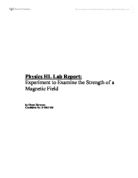By the hypothesis, we use this model formula:.
As from the graph shows,
To find the order or from the model formula we log the equation.
As so:
Next, from that logged model formula we use linear regression to find the value of .
Firstly, take the existing data and log the values in Microsoft Excel.
New logged data:
Secondly graph the data using chart wizard (including a linear trend line)*:
*In the graph, we ignore the uncertainties as it does not affect the equation shown on the chart.
Thirdly, use Microsoft Excel’s option of “Display equation on chart” as shown on the graph above. This will result in [y = -0.5114x + 0.9482]
Remembering the logged model formula:
From the graph we get the value of. The value of or the gradient is -0.5114 however from the logged model formula the value of is negative and hence is 0.5114.
In addition, from equation on chart,. Solving the equation using log, we get:
Hence, the model formula (achieved from our data) is
Conclusion & Evaluation_______________________________________________________
In conclusion, the distance from a magnetic source affects the magnetic field strength. From the model formula gained from the graph: . We can conclude that magnetic field is inversely proportional to distance, with the order of about 0.5114.
As the distance increases, the magnetic field decreases exponentially.
If we test this model formula theoretically, substituting the r (distance) of 4 cm, our result should achieve 3.88 ± 0.00110059 gauss or 3.88 ± 0.028 %* gauss. *To calculate %,
Hence we get
To compare, the difference of our result (ignoring the uncertainty) achieved and from the model formula, the difference is or rounded off to about 0.5 gauss.
To evaluate this problem, first consider the limitations of this experiment. The Pasco Sensor reads the resultant magnetic field of the earth’s individual magnetic field and the magnet bar as well.
As shown, the Pasco reads:
In “Physics For Scientists And Engineers 6E” by Serway and Jewett, the theoretical value of the earth’s magnetic field is about.
This significant value of the earth’s magnetic field explains why there is a difference of 0.48 or about 0.5 gauss (see above example) from the results achieved from our result and from applying the model formula.
A limitation in our experiment is the influencing forces affecting the results. One example is the close distance of a number of people conducting the same experiments that may have affected the magnetic field.
Another limitation is the model formula to find the magnetic field relationship is inaccurate. To calculate the magnetic field from a magnetic bar is not that simple.
As usually we need to account for the direction of the initial magnetic field or the vector direction.
To evaluate that point, another limitation and missing data of our experiment is that we did not record the earth’s magnetic field at the located experiment. As by doing so, we can compare the value with the theoretical value of the earth’s magnetic field of and thus find the % error of our experiment.
An alternative experiment that is aimed to find the relationship of distance from a magnetic source and magnetic field strength is to use a long wire, and having a constant current we alter the distance of the wire and the sensor.
By applying the formula: . We find the relationship between magnetic field strength (), and distance of the sensor (). Using constant values of , and , while having a constant or controlled variable of (current).
References:
Serway and Jewett, “Physics For Scientists And Engineers 6E”.
Owen John & Haese Robert & Haese Sandra & Bruce Mark, “Mathematics for the international student”.







